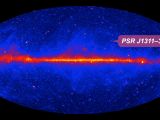Researchers at the Max Planck Institute for Gravitational Physics (Albert Einstein Institute/AEI) in Hanover and the Max Planck Institute for Radio Astronomy have discovered the first pulsar solely by gamma ray radiation. Pulsars are typically found via their radio emissions.
Detecting radio waves from a pulsar is relatively simple, for one, radio waves penetrate the Earth's atmosphere so they can be picked up by ground radio telescopes.
Second, radio telescopes can scan large parts of the sky at a time and look for a pulsating pattern, indicating a pulsar.
The only feasible way of detecting gamma ray radiation is from space and the only instrument capable of detecting a pulsar's gamma ray radiation is the Large Area Telescope aboard the Fermi Gamma-Ray Space Telescope.
This is what the researchers used and tried to discover gamma ray sources that had a fixed period, indicating a pulsar. They scoured through four years of work looking for "blips."
The search is complicated by the fact that very few gamma ray photos hit the telescope, compared to how fast a pulsar spins, making it even harder to detect a pattern.
Still, the researchers found a clear target, PSR J1311-3430. They found a pulsar that spins every 2.5 milliseconds or so, 390 times per second to be exact. The Fermi telescope only picked up one photo from this source every million turns, once every 42 minutes.
While the discovery is historic, the pulsar is quite interesting on its own. It’s accompanied by what seems to be the remnants of another star from which the pulsar is actively feeding. Pulsars with companions from which they feed are known scientifically as "black widows."
This companion is eight times heavier than Jupiter, perhaps more, but it's radius is only 60 percent that of our largest planet.
It's also very close to the pulsar, at only 1.4 times the distance between the Moon and the Earth. The two are orbiting their common center of mass once every 93 minutes.
The companion also explains why the pulsar wasn't detected in the radio spectrum, material from it is being vaporized by the pulsar's gravity and this material blocks any radio wave emitted by the pulsar.
Pulsars are very dense, very fast spinning remnants of stars, a type of neutron stars. They are very small, relative to star sizes, but they are so compact that matter "devolves" into its building blocks, in this case neutrons, hence the name.
Pulsars get their name because they eject a constant stream of high-energy radiation from their magnetic poles.
If the beam happens to be directed at Earth, we'll notice the flash every few milliseconds or every few seconds depending the rotation speed of the pulsar.

 14 DAY TRIAL //
14 DAY TRIAL // 
